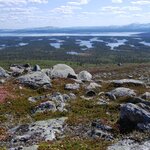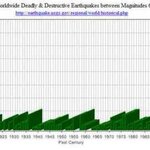Geology
Flowing lava probably carved at least one of the river-like channels on the surface of Mars, according to results of a study presented at the Lunar and Planetary Science Conference at NASA's Goddard Space Flight Center. Whether channels on Mars were formed by water or by lava has been debated for years, and the outcome is thought to influence the likelihood of finding life there.
Geologists carried out a careful study of a single channel on the southwest flank of Mars' Ascraeus Mons, one of the three Tharsis Montes volcanoes. The researchers relied on detailed images from three cameras: the…
Sea ice may have extended to the equator 716.5 million years ago, bringing new precision to a "snowball Earth" event long suspected to have taken place around that time, geologists report this week in Science.
The new findings -- based on an analysis of ancient tropical rocks that are now found in remote northwestern Canada -- bolster the theory that our planet has, at times in the past, been ice-covered at all latitudes.
The survival of eukaryotic life throughout this period indicates sunlight and surface water remained available somewhere on the surface of Earth. The earliest animals arose…

Naked Beauty On Paradise Island
Did you notice that I posted this article under 'geology'. That's because it's about geology. You know - rocks and fossils. This article is also about one of the last unspoiled regions on Earth - Antarctica. So sorry to disappoint.
Vega Island is a small island of the Antarctic Peninsula. If you are a geologist or paleontologist, or Rock whacker or Fossil Huntress then for you, the interior of Vega Island is an unspoiled paradise where rocks and fossils lie, free of ice and snow cover in all their naked beauty.
Vega IslandSource:…

Glaciers, Drumlins and Ripple Moraine
A drumlin is an elongated, streamlined, teardrop-shaped hill formed by glacial action. Its long axis is parallel with the presumed longitudinal flow of a former glacier, with the tail pointing away from the glacier foot. Drumlins often occur in clusters - drumlin fields - with their long axes in approximate alignment.
Ribbed moraine, ripple moraine, or washboard moraine, is glacial terrain with ridges or ripples transverse to glacial flow. These ripples vary greatly in their curved or sinuous form and in their spacing: various classes of…

Geologists at the Woods Hole Oceanographic Institution (WHOI) say the massive, 8.8-magnitude earthquake that struck Chile last week occurred in an offshore zone that was under increased stress caused by a 1960 magnitude 9.5 earthquake.
Some 300-500 times more powerful than the magnitude 7.0 quake in Haiti Jan. 12, the earthquake ruptured at the boundary between the Nazca and South American tectonic plates. The temblor was triggered when the "subducting" Nazca plate was thrust under the South American plate, uplifting a large patch of the seafloor and prompting tsunami warnings…
A new study in Nature Geoscience suggests that an asteroid strike may not only account for the demise of ocean and land life 65 million years ago; the resulting dust, darkness and toxic metal contamination may also explain the geographic unevenness of extinctions and recovery.
Using 823 samples from 17 drilling sites in both the Northern and Southern Hemispheres, researchers analyzed the community structure of calcareous nannoplankton. Included in their study were two sites -- one in the Pacific and one in the South Atlantic -- with reliable, accurate dating.
"At the Cretaceous-Paleogene…

In light of some comments below, and what appears to be an inability to follow a simple link, I accept it is time to rewrite this blog post as one seamless narrative. Thanks to those comments that helped solve the original problem.
19 April 2010, version 2.0
While Haiti is still sorting out the chaos from its January earthquake, the Earth suffers another massive quake in Chile. At a magnitude of 8.8 on the Richter scale this is one of the most powerful earthquakes ever recorded. Concerns about a tsunami spreading across the Pacific have abated and the Chilean authorities claim they have the…

Glacier Sticks Out Tongue - Scientists Say Aaaah!
Ice tongues are a fascinating area of study.They have much to teach us about the life cycles of glaciers.
Many, many years ago, a glacier stuck out its tongue. Recently a rather large chunk of ice, over the course of about two days, broke off just under half of the ice tongue. I wrote about it here. The world's media, perhaps having a shortage of stolen emails and Al Gore movies to write about, trumpeted this non-event as a harbinger of doom, gloom and kaboom!
This event will, we are (mis)informed, kill sealife and, by…
Scientists from the University of Washington sent to collect seismic data and evaluate damage from the devastating magnitude-7 earthquake that struck Haiti have recently released a report documenting their results. The team of civil and environmental engineers says that mass poverty, density of population and lack of building codes were responsible for the widespread devastation.
A survey of 107 buildings in a heavily damaged part of downtown Port-au-Prince found that 28 percent had collapsed and a third will require repairs. A survey of 52 buildings in nearby Léogâne found that more…

The United States Geological Survey (USGS) reports that ice shelves are retreating in the southern section of the Antarctic Peninsula due to climate change. The disappearing ice could lead to sea-level rise if warming continues, threatening coastal communities and low-lying islands worldwide.
Every ice front in the southern part of the Antarctic Peninsula has been retreating overall from 1947 to 2009, according to the USGS, with the most dramatic changes occurring since 1990. Previously documented evidence indicates that the majority of ice fronts on the entire Peninsula have also retreated…